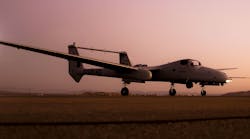The Firebird aircraft developed by Northrop Grumman is unique in that it is an autonomous unmanned aerial system (UAS) that can also be piloted. It features an accessible open architecture that speeds and simplifies the integration of electronic subsystems such as radar and electronic-warfare (EW) systems. By recently running the aircraft through four mission-focused manned flights of each more than 10 hours in length, several different electronic systems were installed onboard the aircraft and allowed to perform during realistic operating conditions. One of these electronic systems was the TK-9 Earthwatch sensor from Overwatch Imaging.
The design of the Firebird permits rapid integration of different sensor systems, and the Earthwatch system was fully integrated and made operational within one day. The TK-9 automated airborne imaging system is so named for its capabilities to capture extensive data from objects on the ground, at sea, or in the air; and to quickly find high-value targets. The Earthwatch system is powered by custom on-board artificial-intelligence (AI) software which sorts through large amounts of target data to narrow a search according to features of interest. The system and software, which are candidates for use by commercial, industrial, and government customers, can be part of an effective and efficient search with a manned or a UAS—the Firebird can operate in either mode.
"During this exercise we rapidly integrated sensors and utilized Firebird’s operational flexibility to demonstrate the system’s unique capability,” said Jane Bishop, vice-president and general manager for autonomous systems for Northrop Grumman. “We leveraged Firebird’s communications suite and data processing power to patch in customers to our virtual feed, so they were able to view flight activities in real time.”
The experimental missions performed wide-area surveillance, high-value subject tracking, hostage recovery, route clearance, and fire-hotspot detection. The Firebird is designed with intelligence, surveillance, and reconnaissance (ISR) capability and can fly to altitudes of 25,000 ft. and has an endurance of 30 hours. Configurations are available for standard autonomous use and optional piloted use.
